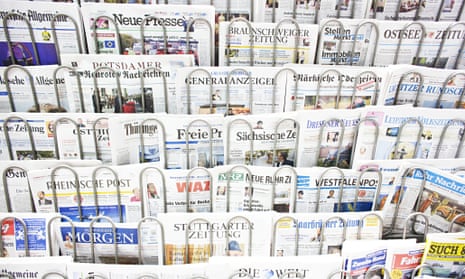Two expert reports – one taking the long view, the other dripping blood on the carpet – define the problems newspapers face as summer fades. The long view comes from Ovum in London, making a five-year forecast for digital consumer publishing. How fares the media world of transition and upheaval? What price print world as – among other things – its pit bulls savage the BBC? One crucial fact, while Tony Hall and his broadcasting legions hymn the wonders of “stability”, is that very little of that exists in the kennel where the attack dogs live.
It would be easy, very easy, to make plans and investments if the transition to digital publishing proceeded at some steady, comforting pace. Yet, Charlotte Miller from Ovum reports, “the resilience of print, despite the growth of mobile and digital consumption, may still be underestimated.
“At an aggregated level, combining revenues from the newspaper, book and magazine industries across more than 50 markets around the world, we forecast that just 24% will come from digital in 2020 – up from 14% in 2015 … So in terms of both consumer and advertiser spend, in spite of a decline in print revenue and all the investment in (and noise around) digital, print will continue to dominate.”
The printing presses “won’t be closing any time soon, even in the US and the UK, where the transition to digital is more rapid”. In those two markets, digital will still only account for a minority of overall revenue in 2020, with shares of 42% and 37% respectively. Of course print “continues to decline in nearly every category and nearly every market”; digital “is where the growth lies, with mobile as the major driver of change. The challenge for publishers, then, is about maximising legacy print revenues while seeking to grow those from digital as rapidly as possible. But are they too quick to kill off their legacy businesses? Publishers must continue to innovate in the digital space …but they can’t afford to kill off print just yet.”
In short, this is a stuttering, uncertain revolution. And so to that blood-spattered carpet: the admirable researchers at Enders Analysis are just as concerned about the last five months as the next five years.
2015 is proving a terrific year for advertising generally. Online, up 13.4% year-on-year, and TV, up 11.5%, are doing famously. Radio and poster sites are faring fine. But newspapers have seen next to nothing of this sunshine. Reckon that print advertising may be 10-11% down by the end of the year – accentuated by a vicious slide over the general election period.
Is this a perfect storm as agencies decide to pay rising TV ad rates by cutting print investment? Possibly: especially when big price wars between supermarkets go quiet as well. But it has all meant a jolting summer for Fleet Street and local papers. Watch £993m of national-paper ad spending in 2014 turn to a forecast £880m this year. Watch local and regional papers see £502m shrink to £449m.
Maybe magazines are a little more resilient, with Private Eye and other favourites bouncing along: but hopes of some general transition from print to tablet have long since perished, and many magazines lack either the reason or the capability to turn into constantly updated online versions. Revenue is heading south at 7.5% a year. There’ll be casualties soon enough.

But the deadliest equation in this melee has always been the balance between print and digital revenues. It has never been – and still shows scant sign of being – a trade-off between equals. The mighty New York Times, for example, under Mark Thompson (below), was trumpeting having topped 1 million online subscribers the other day: a great figure for growth and paywall achievement. Yet what did it mean in simple terms? Margaret Sullivan, the paper’s ombudsman, explained. OK, the magic million would have seemed “eye-popping” and “unimaginable” only a few years ago. But it wouldn’t save the Times all by itself. “Most Times revenue, about 70%, still comes from print. Meanwhile the newsroom and opinion-side operations now cost about $300m a year to support” – and, “despite this encouraging milestone”, the latest earning report shows print advertising still falling.
The question, then, is whether the New York Times – and many more running the same anxious race – can bail fast enough. Look at two UK examples quoted by Enders. Johnston Press reports ad revenue down 5% to £64.1m in the first half of 2015 and digital revenue up 17.5%: but that’s only £16.5m in all, and it doesn’t compensate for print’s decline. Trinity Mirror saw print ads fall 19% in the first half, £20.6m gone; digital grew 26% to £16.6m, but didn’t bridge the gap.
It’s a nervy, standard story. You can tell it on a grand scale if you wish. In America, the Columbia Journalism Review collected a few sorry statistics the other day: US print advertising dropping $1bn a year, another 1,300 full-time editorial jobs gone, shares of some of the bigger chains down between 50% and 66% in a few months. But the tale is repeated time and again as news groups report.
Of course there are success stories. Selling the FT for £844m to Nikkei is a benchmark for transition ambition. Pearson’s £469m for half of the Economist is a similar testament to quality targeting. Jeff Bezos has poured money and hope into the Washington Post. The Guardian, topping 8m uniques in July, reported an online revenue rise of nearly £14m last year. There’s always an opportunity for quality journalism to make its mark – as Facebook and Google, in their separate ways, discover that news platforms are a vital component of their pitch.
Yet, as one baleful summer shows, imperfect storms are always low on the horizon – and falling print reach can also afflict digital revenue growth too, a current Mail Online story. From smartphones to laptops, there is no stability, nor sight of a settled way forward. This is a two-way stretch between long-term prosperity and short-term survival. Which is why, perhaps, the BBC’s fear of that demon “uncertainty” commands so little sympathy on the print side of the street.

